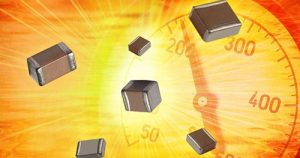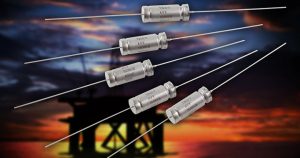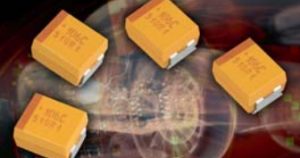FOUNTAIN INN, S.C. (August 10, 2015) – AVX Corporation, a leading manufacturer of passive components and interconnect solutions, has released a new COTS+ version of its TCR Professional Series polymer tantalum chip capacitors. Designed for use in critical military systems, the new TCB Series COTS+ polymer tantalum capacitors feature conductive polymer electrodes, which enable extremely low ESR and reduce the potential for ignition failure. Additionally, each batch undergoes lot conformance testing and additional reliability level verification in order to provide higher reliability than standard polymer tantalum capacitors. Life tested to 0.1% per 1,000 hours with a 90% confidence level, designed to withstand biased humidity testing at 85°C and 80% of rated humidity for 120 hours, and rated for operating temperatures
Learn More →News / Events / Press
FOUNTAIN INN, S.C. (August 6, 2015) – AVX Corporation, a leading manufacturer of passive components and interconnect solutions, has released a new series of tantalum polymer capacitors designed to provide small, high energy, low profile solutions for demanding solid-state drive (SSD) applications. Exhibiting low ESR and the highest energy per volume (Joules/cc) of any comparable SMT capacitor currently available on the market, the new J-CAP Series solid tantalum electrolytic chip capacitors feature conductive polymer electrodes, which exhibit a benign failure mode under recommended use conditions, and undertab terminations, which enable high volumetric efficiency in small, low profile case sizes and, subsequently, close positioning for efficient, high density PCB layouts. Combined, these attributes reduce both cost and footprint in multilevel cell
Learn More →FOUNTAIN INN, S.C. (July 20, 2015) – AVX Corporation, a leading manufacturer of passive components and interconnect solutions, has announced that, after several years of extensive testing, the National Aeronautics and Space Administration (NASA) has approved its space-level X7R base metal electrode (BME) multilayer ceramic capacitors (MLCCs) for use in US military and aerospace applications under the criteria of the S-311-P-838 specification. This specification defines the requirements for high reliability, ceramic dielectric, multilayer, base-metal electrode, fixed value chip capacitors for high reliability space applications, in addition to the processing verification and inspections required by assemblies used in flight, and officially makes AVX the first (and currently only) supplier of BME capacitors approved for use in US space applications. Exhibiting capacitance
Learn More →FOUNTAIN INN, S.C. (July 15, 2015) – AVX Corporation, a leading manufacturer of passive components and interconnect solutions, has introduced the new T4J Medical Series tantalum SMD capacitors. Specifically designed for use in implantable non-life-support and non-implantable life support medical applications, T4J Medical Series capacitors exhibit high standard reliability of fewer than 0.1% failures per 1,000 hours at 25°C and rated voltage, which is 10 times better than standard commercial reliability, and low standard leakage current (DCL) values of 0.01CV. Manufactured and screened using AVX’s patented and extremely effective Q-Process to ensure the removal of any components that may experience parametric shifts through customer processing or display instability through life testing, T4J Medical Series capacitors feature two levels of statistical
Learn More →FOUNTAIN INN, S.C. (July 13, 2015) – AVX Corporation, a leading manufacturer of passive components and interconnect solutions, has extended its high temperature AT Series MLCCs with two new case sizes (0603 and 0805), two new voltage ratings (16V VHT 250°C and 25V VHT 200°C), and new C0G and VHT temperature coefficients that differentiate the 200°C parts from the industry-leading 250°C parts. Designed to accommodate emerging military and commercial market demands for capacitors capable of high-reliability, long lifetime performance at operating temperatures in excess of the current 125°C requirement, AT Series capacitors are the only high temperature MLCCs with reliability test data at 250°C, and are rated at both 250°C and 200°C to provide engineers with optimal derating schemes. The
Learn More →FOUNTAIN INN, S.C. (July 9, 2015) — AVX Corporation, a leading manufacturer of advanced passive components and interconnect solutions, has introduced the new radial leaded CapGuard™ Automotive Series. Combining multilayer varistor (MLV) and high capacitance, temperature stable X7R multilayer ceramic capacitor (MLCC) technology in a single, high-reliability device, the new CapGuard Series exhibits bi-directional transient voltage protection, excellent EMI/RFI attenuation over a wide frequency spectrum, and multi-strike capabilities in a compact, radial configuration with a conformal epoxy coating that provides enhanced resistance against harsh environments, mechanical shock, and vibration. Qualified to AEC-Q200, CapGuard devices exhibit exceptional current and energy handling capabilities, and are ideally suited to protect sensitive electronics from high voltage transients, as well as to filter out high
Learn More →FOUNTAIN INN, S.C. (June 30, 2015) – AVX Corporation, a leading manufacturer of passive components and interconnect solutions, has introduced a new series of wet tantalum capacitors designed for use at 200°C, many of which are capable of up to 2,000 hours of operation with applicable derating. Featuring a high capacitance cathode system that enables high CV performance in standard DSCC case sizes spanning T1 – T4, the new TWA-Y Series delivers high reliability, high temperature, and long lifetime performance, and exhibits stable electrical parameters over temperature (-55°C to +200°C). Hermetically sealed in a welded tantalum can and header assembly, TWA-Y Series capacitors satisfy the harsh mechanical shock and high frequency vibration requirements for both MIL-PRF-39006 and MIL-STD-202, making them
Learn More →FOUNTAIN INN, S.C. (June 25, 2015) – AVX Corporation, a leading manufacturer of passive components and interconnect solutions, has received a silver-level 2014 Perfect Order Index (POI) Award in the Passive Electromechanical Components Supplier category from Arrow Electronics, a global provider of products, services, and solutions to industrial and commercial users of electronic components and enterprise computing solutions. Launched in 2012, the Perfect Order Index Awards recognize Arrow suppliers that achieve best-in-class performance by delivering perfect orders, as measured by the same eight metrics to which Arrow holds itself accountable with regard to on-time delivery and end-to-end customer quality, including: the right product, the right quality, and delivery at the right place and the right time. “Arrow congratulates all of
Learn More →FOUNTAIN INN, S.C. (June 24, 2015) – AVX Corporation, a leading manufacturer of passive components and interconnect solutions, has added more than a dozen new high-reliability SMD tantalum capacitors to its TMJ S1gma™ Series, which exhibits the lowest DCL and twice the reliability of any commercial grade tantalum capacitors currently on the market (0.005CV standard and 0.001CV on selected codes), in addition to an impressively scant baseline part failure rate of < 0.5% per 1,000 hours at 85°C and rated voltage. Available with three levels of next-generation statistical screening and process control enhancement for applications in which exceedingly high reliability, extremely low DC leakage current (DCL), and extended battery life are paramount, the new TMJ S1gma Series capacitors are ideal
Learn More →FOUNTAIN INN, S.C. (June 22, 2015) — AVX Corporation, a leading manufacturer of passive components and interconnect solutions, has announced that, after several years of extensive testing, its space-level X7R base metal electrode (BME) MLCCs have achieved the European Space Association’s (ESA’s) Qualified Parts List (QPL) status under the criteria of the European Space Components Coordination’s (ESCC’s) 3009/041 specification, making them the first X7R BME MLCCs fully qualified for use in European and American space applications. Exhibiting capacitance voltage (CV) capabilities superior to those of traditional precious metal electrode (PME) MLCCs, AVXs space-level BME MLCCs provide the extremely high reliability performance required by the space industry while delivering higher capacitance values in significantly smaller cases sizes, enabling revolutionary reductions of
Learn More →FOUNTAIN INN, S.C. (June 16, 2015) — AVX Corporation, a leading manufacturer of passive components and interconnect solutions, has been globally honored with prestigious 2014 TTI Supplier Excellence Awards for having earned the award in each of the company’s three regions: Europe, Asia, and the Americas. Bestowed by TTI, Inc., the leading authorized distributor of interconnect, passive, electromechanical, and discrete components, the TTI Supplier Excellence Awards recognize AVX for its successful fulfillment of several key quality performance metrics intended to elevate supplier and distributor performance in order to ensure utmost customer satisfaction worldwide. Representing the highest possible recognition of a supplier’s performance with regard to quality acceptance, ship-to-commit delivery date, effective business systems, ease of doing business, and both the
Learn More →FOUNTAIN INN, S.C. (June 15, 2015) — AVX Corporation, a leading manufacturer of passive components and interconnect solutions, has introduced a new web-based simulation tool for its tantalum, polymer, and niobium oxide capacitors. Featuring data mined from the libraries of AVX’s previous PSpice Models and S-Parameters S2P software, which, now redundant, have been removed from the website, the new, interactive SpiTAN IV software provides design engineers with a user-friendly program for reviewing critical electrical and performance characteristics for individual part numbers by temperature and frequency, allowing them to identify and accurately select the optimum capacitors for their applications. Searchable by part number or product type — the list of which currently includes: low profile, high CV, low ESR, polymer, niobium
Learn More →FOUNTAIN INN, S.C. (May 14, 2015) — AVX Corporation, a leading manufacturer of advanced passive components and interconnect solutions, has added a new 1206 chip size and extensive new voltage, clamping voltage, and energy ratings to its Glass Encapsulated TransGuard® and TransGuard Automotive Series multilayer varistors. Comprised of zinc oxide (ZnO) based ceramic semiconductor devices with non-linear, bi-directional voltage-current (V–I) characteristics similar to those of back-to-back Zener diodes, both multilayer varistor series provide bi-directional overvoltage protection and EMI/RFI attenuation in a single SMT package, exhibit high current and energy handling capabilities, and are glass encapsulated to provide enhanced resistance against harsh environments and processes, including acids, salt, and chlorine flux. Both series also exhibit sub 1nS response times to ESD
Learn More →FOUNTAIN INN, S.C. (May 13, 2015) – AVX Corporation, a leading manufacturer of passive components and interconnect solutions, has added a single contact, wire-to-board (WTB) insulation displacement connector (IDC) with plated through hole (PTH) terminations to its proven 9176 Series, which, prior to the addition, was exclusively comprised of surface mount technology (SMT) connectors. Delivering the same features and benefits for which the 9176 Series is known — including a gas-tight connection to the PCB for long-term reliability, preassembled strain relief caps with through-wire or end-stop configurations for maximum flexibility, reduced cost compared to hand soldering and two-piece connector options, and the tested ability to withstand automotive levels of shock, vibration, and temperature cycling — the new single tine 9176-60X
Learn More →FOUNTAIN INN, S.C. (May 12, 2015) – AVX Corporation, a leading manufacturer of passive components and interconnect solutions, has introduced the new SV Series high voltage, automotive grade, multilayer ceramic (MLC), radial-leaded capacitors. Qualified to AEC-Q200 and rated for 1,000VDC, the new SV Series capacitors are designed with C0G (NP0) Class I dielectric materials, which exhibit an extremely low dissipation factor — providing excellent high rms current handling capabilities with minimal power losses in medium to high power resonant converters — and radial leads, which enable the mechanical decoupling of the MLC chip from the board, and provide the maximum mechanical stress relief necessary for harsh automotive applications. Conformally coated to eliminate the potential for arc flashover, SV Series capacitors
Learn More →FOUNTAIN INN, S.C. (May 12, 2015) – AVX Corporation, a leading manufacturer of passive components and interconnect solutions, has released a new 2mm vertical poke-home wire-to-board (WTB) contact. The latest addition to AVX’s 70-9296 Series, the new micro contact accepts 26–22AWG solid or stranded wires, supports current ratings as high as 8A, and is 37% smaller than the next smallest offering in the series (a 3mm vertical poke home WTB contact), which makes it compatible with smaller wire gauges and devices, and extends the applications for the series to light industrial electronics, such as display case and under cabinet SSL products with lower current and shorter runs, switches, lighting strips, and motion, pressure, and temperature sensors, amongst several others. The
Learn More →















